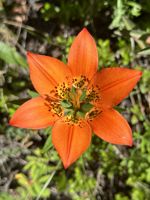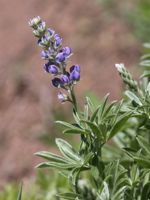Mon-Fri 9am - 5pm Mountain time
Wood Lily vs Silky Lupine
Lilium philadelphicum
Lupinus sericeus
CUSTOM GROW
CUSTOM GROW
Wood Lily is a native perennial wildflower known for its vibrant, trumpet-shaped blooms in shades of orange to red. Its showy flowers appear mid-summer and are highly visible in meadows and prairies. The upward-facing flowers are an important nectar source for many pollinators, including native bees, butterflies, and hummingbirds.
Unlike most lilies, the Wood Lily’s flowers face upward rather than nodding. It is slow to establish and may take years before flowering, but once mature, it requires little maintenance. It is well-suited for pollinator gardens, naturalisation projects, prairie restoration, and open woodland plantings.
Wood Lily is the provincial flower of Saskatchewan and North America’s most widespread lily. Despite its wide natural range, populations have been declining. Habitat loss, overgrazing by deer, and unsustainable picking have reduced both its abundance and density across many regions. These pressures highlight the importance of protecting and restoring this once-common wildflower.
Silky Lupine is a native perennial wildflower known for its upright spikes of blue to violet flowers. Blooming from late spring into summer, the nectar-rich, showy blossoms attract a variety of pollinators, especially bees and butterflies. The plant’s fine, silky foliage provides soft texture and visual interest, enhancing landscapes throughout the growing season.
Silky Lupine is a nitrogen-fixing plant that enriches soils and supports surrounding vegetation. Its deep roots stabilize soil, and it spreads naturally by ejecting seeds from drying pods. If spread isn’t desired, new seedlings are easy to remove. While it is foraged by some wild animals, it contains alkaloids that are toxic to livestock. Silky Lupine is well-suited to pollinator gardens, naturalization plantings, erosion control, and ecological restoration projects.

